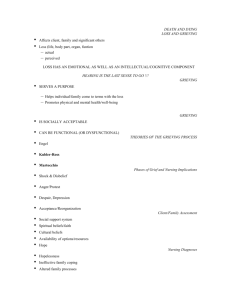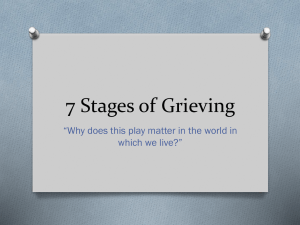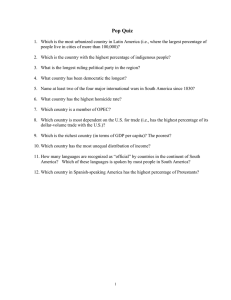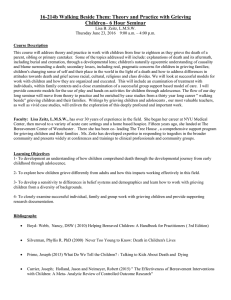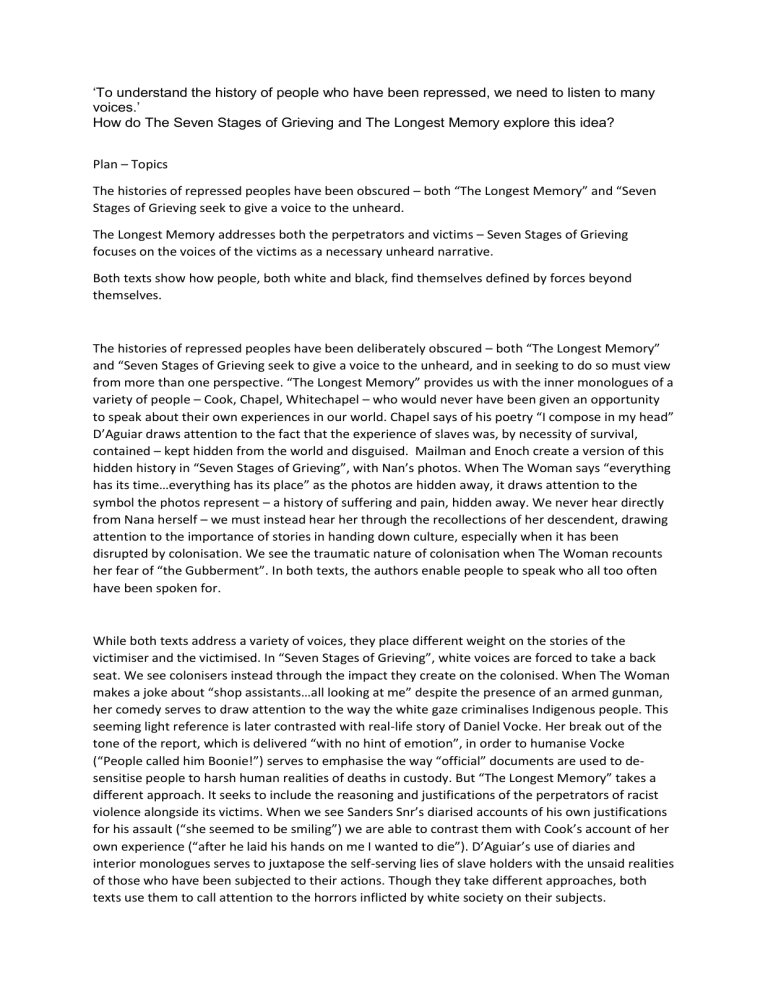
‘To understand the history of people who have been repressed, we need to listen to many voices.’ How do The Seven Stages of Grieving and The Longest Memory explore this idea? Plan – Topics The histories of repressed peoples have been obscured – both “The Longest Memory” and “Seven Stages of Grieving seek to give a voice to the unheard. The Longest Memory addresses both the perpetrators and victims – Seven Stages of Grieving focuses on the voices of the victims as a necessary unheard narrative. Both texts show how people, both white and black, find themselves defined by forces beyond themselves. The histories of repressed peoples have been deliberately obscured – both “The Longest Memory” and “Seven Stages of Grieving seek to give a voice to the unheard, and in seeking to do so must view from more than one perspective. “The Longest Memory” provides us with the inner monologues of a variety of people – Cook, Chapel, Whitechapel – who would never have been given an opportunity to speak about their own experiences in our world. Chapel says of his poetry “I compose in my head” D’Aguiar draws attention to the fact that the experience of slaves was, by necessity of survival, contained – kept hidden from the world and disguised. Mailman and Enoch create a version of this hidden history in “Seven Stages of Grieving”, with Nan’s photos. When The Woman says “everything has its time…everything has its place” as the photos are hidden away, it draws attention to the symbol the photos represent – a history of suffering and pain, hidden away. We never hear directly from Nana herself – we must instead hear her through the recollections of her descendent, drawing attention to the importance of stories in handing down culture, especially when it has been disrupted by colonisation. We see the traumatic nature of colonisation when The Woman recounts her fear of “the Gubberment”. In both texts, the authors enable people to speak who all too often have been spoken for. While both texts address a variety of voices, they place different weight on the stories of the victimiser and the victimised. In “Seven Stages of Grieving”, white voices are forced to take a back seat. We see colonisers instead through the impact they create on the colonised. When The Woman makes a joke about “shop assistants…all looking at me” despite the presence of an armed gunman, her comedy serves to draw attention to the way the white gaze criminalises Indigenous people. This seeming light reference is later contrasted with real-life story of Daniel Vocke. Her break out of the tone of the report, which is delivered “with no hint of emotion”, in order to humanise Vocke (“People called him Boonie!”) serves to emphasise the way “official” documents are used to desensitise people to harsh human realities of deaths in custody. But “The Longest Memory” takes a different approach. It seeks to include the reasoning and justifications of the perpetrators of racist violence alongside its victims. When we see Sanders Snr’s diarised accounts of his own justifications for his assault (“she seemed to be smiling”) we are able to contrast them with Cook’s account of her own experience (“after he laid his hands on me I wanted to die”). D’Aguiar’s use of diaries and interior monologues serves to juxtapose the self-serving lies of slave holders with the unsaid realities of those who have been subjected to their actions. Though they take different approaches, both texts use them to call attention to the horrors inflicted by white society on their subjects.

